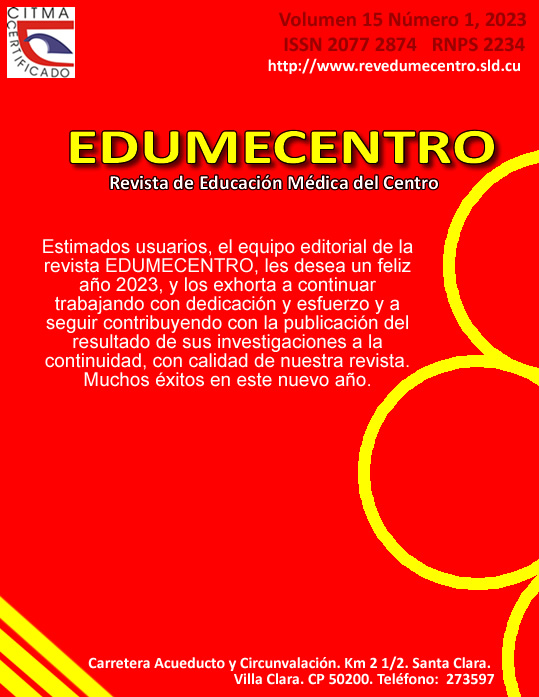Risk perception regarding HIV/AIDS transmission among students from the University of Chile
Keywords:
HIV, risk, social behavior, sexual vulnerability, protective factors, education, medicalAbstract
Background: being updated is an influencial mediator of risk behaviors, but it is not determinant. To know the risk is not enough to put in practice prevetive behaviors since there are others factors that could influence upon sexual behavior, as the risk perception.
Objective: to determine the perception about the risk of getting and/or transmitting HIV / AIDS, among students from the University of Chile, Faculty of Medicine, 2020, and with a gender perspective.
Methods: a qualitative research with a phenomenological approach of descriptive exploratory type, with students from the Faculty of Medicine of the University of Chile, was carried out in 2020. Theoretical methods were used: analysis-synthesis, inductive-deductive and historical-logical methods; and empirical ones: semi-structured individual interviews. To get the information, narrative content analysis was applied.
Results: students showed their knowledge regarding HIV/AIDS, the mechanisms of transmission, treatment and prevention of it. Most of them refer using barrier methods, although they distinguish the use of it depending on what if it is a casual or stable relationship. In case of stable relationships, the perception of risk seems to be lower, associated with the non-use of condoms for trust and pleasure, among others.
Conclusions: the theoretical management of the topic is not sufficient for the increase of self-perception risk and preventive behaviors be adopted. Knowing the elements that influence on risk perception is relevant to achieve effective sexual education programs, taking into account sociocultural factors in addition to the communication of information.
Downloads
References
1. Organización Mundial de la Salud. Estrategia Mundial del sector salud contra el VIH 2016-2021 [Internet]. Ginebra: OMS; 2016. Disponible en: https://apps.who.int/iris/bitstream/handle/10665/250574/WHO-HIV-2016.05-spa.pdf;jsessionid=BF2447AEEDB84579E8D5B9D871D8527E?sequence=1
2. Ministerio de Salud. Instituto de Salud Pública. Resultados confirmación de infección por VIH en Chile. 2010 - 2018. [Internet]. Chile: Boletín vigilancia de laboratorio; 2019. Disponible en: http://www.ispch.cl/sites/default/files/BoletinVIH-15112017A.pdf
3. ONUSIDA. Actualización de los datos globales sobre sida: un largo camino por recorrer. La respuesta al VIH en América Latina [Internet]. 2018. Disponible en: http://onusidalac.org/1/images/2018/miles-to-go_latin-america_es.pdf
4. Cáceres Burton K, Pino Aravena R. Estimaciones poblacionales sobre VIH en Chile 2017 [Internet]. Chile: Minsal; 2018. Disponible en: http://epi.minsal.cl
5. Goldstein E. Evolución de VIH/SIDA en Chile y países seleccionados de América Latina. [Internet]. Chile: Minsal; 2019. Disponible en: http://epi.minsal.cl/wp-content/uploads/2017/12/Especificación-de-la-información
6. ONUSIDA. 90-90-90 Un ambicioso objetivo de tratamiento para contribuir al fin de la epidemia de sida [Internet]. 2018 [citado 24 de junio de 2019]. Disponible en: https://www.unaids.org/sites/default/files/media_asset/90_90_90_es.pdf
7. UNESCO. Orientaciones técnicas internacionales sobre educación en sexualidad, un enfoque basado en evidencia. 2018. Disponible en: https://unesdoc.unesco.org/ark:/48223/pf0000265335
8. Molina R, Alarcón S, Molina T. Evaluación de un curso online de educación sexual integral escolar de autoaprendizaje para público en general. Curso MOOC. Rev Chil Obstet Ginecol [Internet]. 2023 [citado 23/06/2023];88(1):[aprox. 7 p.]. Disponible en: http://www.scielo.cl/scielo.php?script=sci_arttext&pid=S0717-75262023000100002&lng=es
9. Organización Mundial de la Salud. La salud sexual y su relación con la salud reproductiva: un enfoque operativo [Internet]. 2018. Ginebra: OMS; 2018. Disponible en: https://apps.who.int/iris/bitstream/handle/10665/274656/9789243512884-spa.pdf?ua=1
10. Farahani FK, Akhondi MM, Shirzad M, Azin A. HIV/STI risk-taking sexual behaviours and risk perception among male university students in Tehran: Implications for HIV prevention among youth. J Biosoc Sci [Internet]. 2018 [citado 19/05/2022];50(1):[aprox. 15 p.]. Disponible en: https://pubmed.ncbi.nlm.nih.gov/28285603/
11. Saura S, Jorquera V, Rodríguez D, Mascort C, Castellá I, García J. Gender meanings of the risk of sexually transmitted infections/HIV transmission among young people. Aten Primaria [Internet]. 2019 [citado 20/05/2022];51(2):[aprox. 10 p.]. Disponible en: http://dx.doi.org/10.1016/j.aprim.2017.08.005
12. Ndugwa Kabwama S, Berg-Beckhoff G. The association between HIV/AIDS-related knowledge and perception of risk for infection: A systematic review. Perspect Public Health [Internet]. 2015 [citado 08/05/2022];135(6):[aprox. 9 p.]. Disponible en: https://pubmed.ncbi.nlm.nih.gov/26253643/
13. Fenández MA. Relación entre el conocimiento de los mecanismos de transmisión del VIH y la percepción del riesgo de infección en Guayaquil, Ecuador. Rev Chil Salud Pública [Internet]. 2012 [citado 13/05/2022];16(2):[aprox. 8 p.]. Disponible en: https://revistasaludpublica.uchile.cl/index.php/RCSP/article/view/20283/21462
14. Estrella López BC, Saa Sabando BF, Caicedo Rodríguez JO. Propuesta educativa para mejorar la percepción de riesgo de contagio del VIH en estudiantes universitarios. Conrado. [Internet]. 2022 [citado 30/08/2022];18(87):[aprox. 9 p.]. Disponible en: http://scielo.sld.cu/scielo.php?script=sci_arttext&pid=S1990-86442022000400200&lng=es&tlng=es
15. Telpiz-de la Cruz SG, Rubiano-Mesa YL, Castejón JL. Influencia de los factores de vulnerabilidad al VIH/sida sobre comportamientos sexuales de riesgo en adolescentes. Rev Latinoam de Psicología [Internet]. 2023 [citado 30/08/2022];55:[aprox. 10 p.]. Disponible en: https://doi.org/10.14349/rlp.2023.v55.7
Published
How to Cite
Issue
Section
License
Los autores que publican en esta revista están de acuerdo con los siguientes términos:- Los autores/as conservarán sus derechos de autor y ceden a la revista el derecho de primera publicación de su obra, el cuál estará simultáneamente sujeto a una Licencia Creative Commons Reconocimiento-NoComercial-CompartirIgual 4.0 Internacional (CC BY-NC-SA 4.0) que permite a terceros compartir la obra siempre que se indique su autor y su primera publicación esta revista.
- Los autores pueden establecer por separado acuerdos adicionales para la distribución no exclusiva de la versión de la obra publicada en la revista (por ejemplo, situarlo en un repositorio institucional o publicarlo en un libro), con un reconocimiento de su publicación inicial en esta revista.
- Se permite y se anima a los autores a difundir sus trabajos electrónicamente (por ejemplo, en repositorios institucionales o en su propio sitio web) antes y durante el proceso de envío, ya que puede dar lugar a intercambios productivos, así como a una citación más temprana y mayor de los trabajos publicados (Véase The Effect of Open Access) (en inglés).










